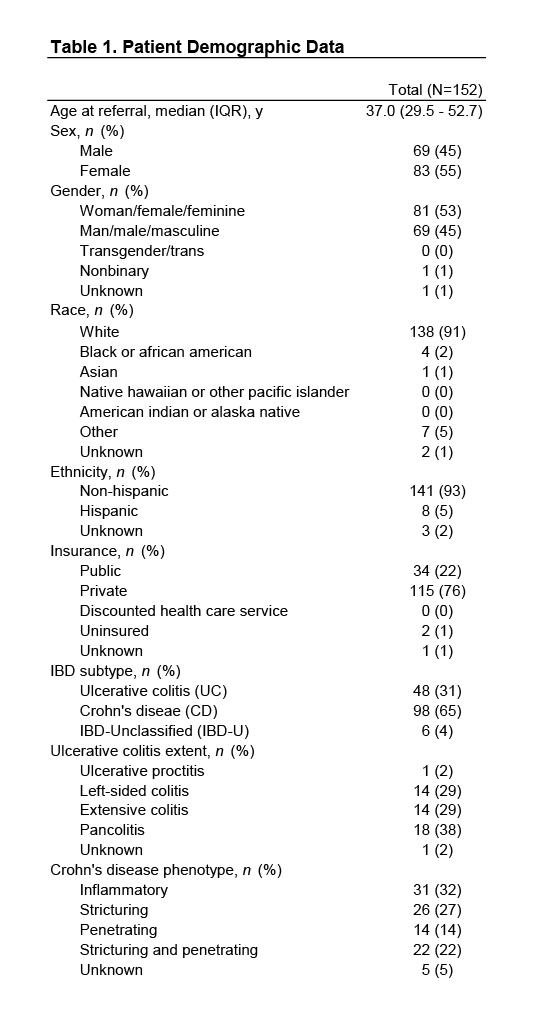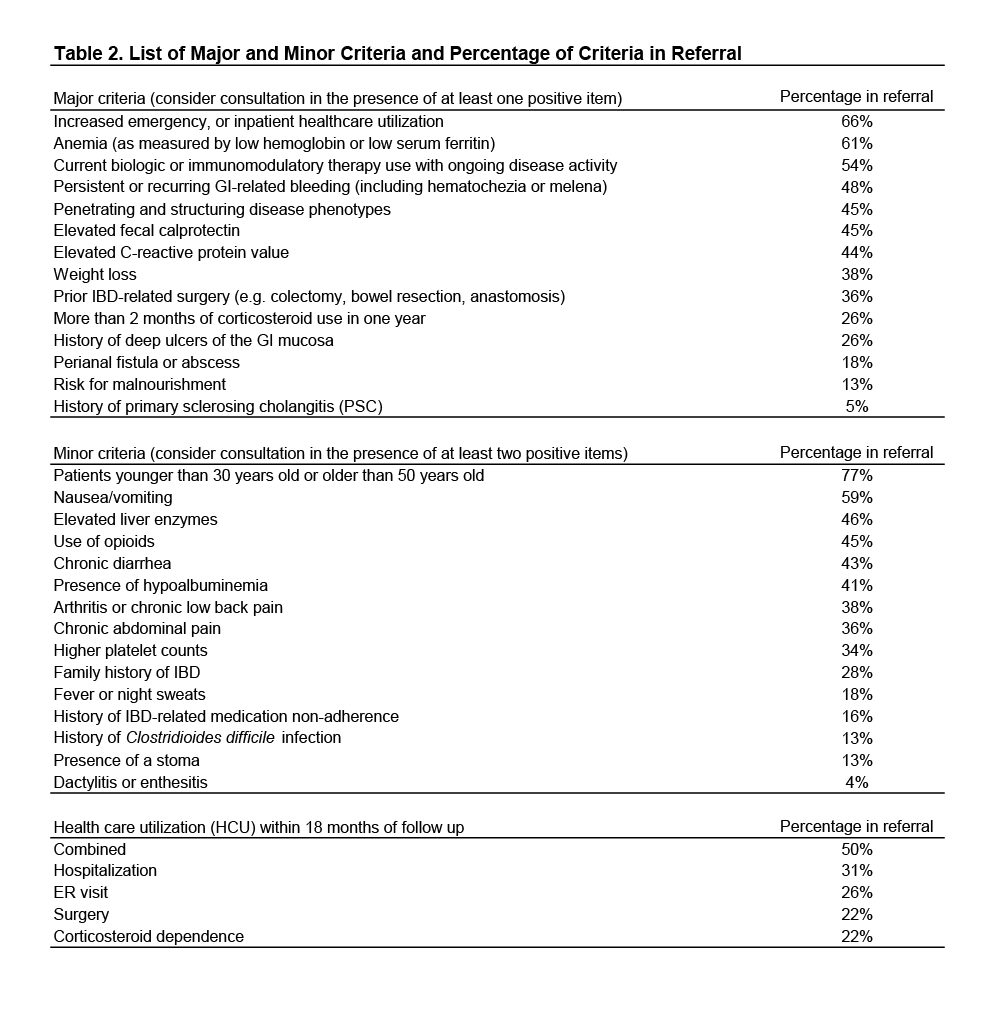Sunday Poster Session
Category: IBD
P1163 - Identifying Factors From an IBD Care Referral Pathway Associated With Referral to a Tertiary Care Referral Center, Time to Referral, and IBD-Related Healthcare Utilization
Sunday, October 26, 2025
3:30 PM - 7:00 PM PDT
Location: Exhibit Hall

Nancy Wu, MD, PhD (she/her/hers)
University of Colorado Anschutz Medical Campus
Englewood, CO
Presenting Author(s)
Nancy Wu, MD, PhD1, Hadley Greenwood, MD2, Keanna Capener, BS3, Frank I. Scott, MD, MSCE3
1University of Colorado Anschutz Medical Campus, Englewood, CO; 2University of Colorado Anschutz Medical Campus, Denver, CO; 3University of Colorado Anschutz Medical Campus, Aurora, CO
Introduction: Delays in the diagnosis and treatment of IBD remain a significant challenge. These delays are associated with increased risks of adverse outcomes. Previously, a referral care pathway was created to identify criteria for triaging IBD patients who would benefit from IBD specialist consultation. This study sought to identify the frequency of these criteria among individuals referred to an IBD center at a large tertiary care referral center in USA and to measure the time from meeting referral criteria and referral.
Methods: A retrospective cohort study was conducted of adults with IBD referred to a tertiary IBD center from 1/1/2019-12/31/2022. Records were reviewed to identify when pathway criteria would have been met. Dates for when criteria were met, when referral was placed, and when they established with IBD center were recorded. IBD-related healthcare utilization (HCU), defined as IBD-related ER visits, hospitalizations, and/or surgeries, was assessed for 18 months after referral. Corticosteroid-dependence was assessed as a secondary outcome. Baseline characteristics included patient demographics, insurance type, and IBD subtype and phenotype. Descriptive statistics were used to describe cohort characteristics, time to referral, and HCU.
Results: 152 individuals were included. Baseline demographics are presented in Table 1. Percentages of major and minor criteria are summarized in Table 2. The most frequent major and minor criteria were increased ER or inpatient HCU (66%) and IBD diagnosis age < 30 or > 50 years old (77%). The median time from meeting criteria for referral and being seen at the IBD clinic were 8.9 years [IQR 3.9 – 17.3] and 9.2 years [IQR 4.2 – 17.5]. Median time from referral to visit was 61.0 days [IQR 28.3 – 116.5]. 50% of referred individuals had as least one measured IBD-related HCU. More HCU were observed in individuals with non-private insurance for the combined HCU outcome (64.9% vs 45.2%), ER visits (40.5% vs 20.8%), inpatient visits (37.8% vs 28.7%), and surgeries (32.4% vs 18.2%).
Discussion: In this retrospective study, criteria previously defined by the IBD care referral pathway were common among patients referred to a large tertiary IBD referral center. Extended periods of time from meeting criteria to referral were identified, HCU was common, particularly in those with non-private insurance. Future analyses will identify criteria associated with longest delays and measure the association between delays and HCU.

Figure: Table 1. Patient demographic data. This table summarized patient demographic data of 152 individuals included in this retrospective cohort study. All 152 individuals had followed with IBD clinic for at least 18 months after referral. Baseline characteristics included patient demographics, insurance type, and IBD subtype and phenotype.

Figure: Table 2. List of major and minor criteria and percentage of criteria in referral. Previously, a novel referral care pathway was created to identify individuals with IBD who could benefit from IBD expert consultation. There were 13 major criteria and 15 minor criteria. It was recommended that 1 major or 2 or more minor criteria should be required to consider IBD specialist consultation. This table summarized the percentage of these criteria assessed in our study (listed from most to least frequent orders in both major and minor criteria). IBD-related health care utilization (HCU) was defined as IBD-related ER visits, hospitalizations, and/or surgeries. Corticosteroid-dependence, defined as greater than 8 weeks of steroid exposure during available follow-up, was assessed as a secondary outcome. The first of any outcome defined the timing of the primary combined outcome. IBD-related HCU was assessed by the end of 18-month follow up.
Disclosures:
Nancy Wu indicated no relevant financial relationships.
Hadley Greenwood indicated no relevant financial relationships.
Keanna Capener indicated no relevant financial relationships.
Frank Scott indicated no relevant financial relationships.
Nancy Wu, MD, PhD1, Hadley Greenwood, MD2, Keanna Capener, BS3, Frank I. Scott, MD, MSCE3. P1163 - Identifying Factors From an IBD Care Referral Pathway Associated With Referral to a Tertiary Care Referral Center, Time to Referral, and IBD-Related Healthcare Utilization, ACG 2025 Annual Scientific Meeting Abstracts. Phoenix, AZ: American College of Gastroenterology.
1University of Colorado Anschutz Medical Campus, Englewood, CO; 2University of Colorado Anschutz Medical Campus, Denver, CO; 3University of Colorado Anschutz Medical Campus, Aurora, CO
Introduction: Delays in the diagnosis and treatment of IBD remain a significant challenge. These delays are associated with increased risks of adverse outcomes. Previously, a referral care pathway was created to identify criteria for triaging IBD patients who would benefit from IBD specialist consultation. This study sought to identify the frequency of these criteria among individuals referred to an IBD center at a large tertiary care referral center in USA and to measure the time from meeting referral criteria and referral.
Methods: A retrospective cohort study was conducted of adults with IBD referred to a tertiary IBD center from 1/1/2019-12/31/2022. Records were reviewed to identify when pathway criteria would have been met. Dates for when criteria were met, when referral was placed, and when they established with IBD center were recorded. IBD-related healthcare utilization (HCU), defined as IBD-related ER visits, hospitalizations, and/or surgeries, was assessed for 18 months after referral. Corticosteroid-dependence was assessed as a secondary outcome. Baseline characteristics included patient demographics, insurance type, and IBD subtype and phenotype. Descriptive statistics were used to describe cohort characteristics, time to referral, and HCU.
Results: 152 individuals were included. Baseline demographics are presented in Table 1. Percentages of major and minor criteria are summarized in Table 2. The most frequent major and minor criteria were increased ER or inpatient HCU (66%) and IBD diagnosis age < 30 or > 50 years old (77%). The median time from meeting criteria for referral and being seen at the IBD clinic were 8.9 years [IQR 3.9 – 17.3] and 9.2 years [IQR 4.2 – 17.5]. Median time from referral to visit was 61.0 days [IQR 28.3 – 116.5]. 50% of referred individuals had as least one measured IBD-related HCU. More HCU were observed in individuals with non-private insurance for the combined HCU outcome (64.9% vs 45.2%), ER visits (40.5% vs 20.8%), inpatient visits (37.8% vs 28.7%), and surgeries (32.4% vs 18.2%).
Discussion: In this retrospective study, criteria previously defined by the IBD care referral pathway were common among patients referred to a large tertiary IBD referral center. Extended periods of time from meeting criteria to referral were identified, HCU was common, particularly in those with non-private insurance. Future analyses will identify criteria associated with longest delays and measure the association between delays and HCU.

Figure: Table 1. Patient demographic data. This table summarized patient demographic data of 152 individuals included in this retrospective cohort study. All 152 individuals had followed with IBD clinic for at least 18 months after referral. Baseline characteristics included patient demographics, insurance type, and IBD subtype and phenotype.

Figure: Table 2. List of major and minor criteria and percentage of criteria in referral. Previously, a novel referral care pathway was created to identify individuals with IBD who could benefit from IBD expert consultation. There were 13 major criteria and 15 minor criteria. It was recommended that 1 major or 2 or more minor criteria should be required to consider IBD specialist consultation. This table summarized the percentage of these criteria assessed in our study (listed from most to least frequent orders in both major and minor criteria). IBD-related health care utilization (HCU) was defined as IBD-related ER visits, hospitalizations, and/or surgeries. Corticosteroid-dependence, defined as greater than 8 weeks of steroid exposure during available follow-up, was assessed as a secondary outcome. The first of any outcome defined the timing of the primary combined outcome. IBD-related HCU was assessed by the end of 18-month follow up.
Disclosures:
Nancy Wu indicated no relevant financial relationships.
Hadley Greenwood indicated no relevant financial relationships.
Keanna Capener indicated no relevant financial relationships.
Frank Scott indicated no relevant financial relationships.
Nancy Wu, MD, PhD1, Hadley Greenwood, MD2, Keanna Capener, BS3, Frank I. Scott, MD, MSCE3. P1163 - Identifying Factors From an IBD Care Referral Pathway Associated With Referral to a Tertiary Care Referral Center, Time to Referral, and IBD-Related Healthcare Utilization, ACG 2025 Annual Scientific Meeting Abstracts. Phoenix, AZ: American College of Gastroenterology.
